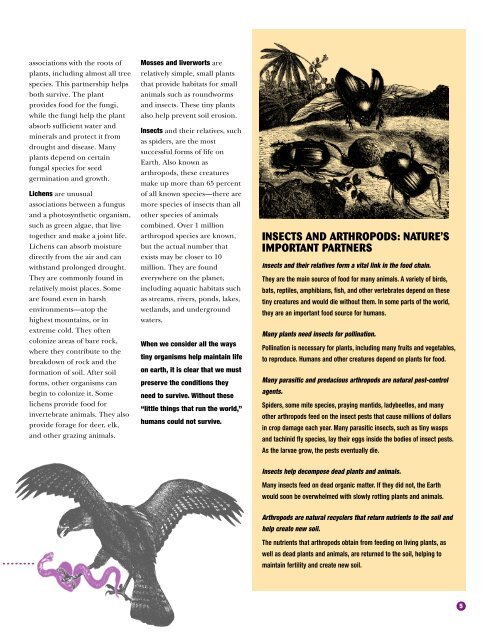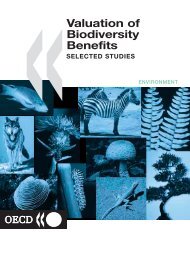Biodiversity: Our Living World-Your Life Depends on It!
Biodiversity: Our Living World-Your Life Depends on It!
Biodiversity: Our Living World-Your Life Depends on It!
You also want an ePaper? Increase the reach of your titles
YUMPU automatically turns print PDFs into web optimized ePapers that Google loves.
associati<strong>on</strong>s with the roots of<br />
plants, including almost all tree<br />
species. This partnership helps<br />
both survive. The plant<br />
provides food for the fungi,<br />
while the fungi help the plant<br />
absorb sufficient water and<br />
minerals and protect it from<br />
drought and disease. Many<br />
plants depend <strong>on</strong> certain<br />
fungal species for seed<br />
germinati<strong>on</strong> and growth.<br />
Lichens are unusual<br />
associati<strong>on</strong>s between a fungus<br />
and a photosynthetic organism,<br />
such as green algae, that live<br />
together and make a joint life.<br />
Lichens can absorb moisture<br />
directly from the air and can<br />
withstand prol<strong>on</strong>ged drought.<br />
They are comm<strong>on</strong>ly found in<br />
relatively moist places. Some<br />
are found even in harsh<br />
envir<strong>on</strong>ments—atop the<br />
highest mountains, or in<br />
extreme cold. They often<br />
col<strong>on</strong>ize areas of bare rock,<br />
where they c<strong>on</strong>tribute to the<br />
breakdown of rock and the<br />
formati<strong>on</strong> of soil. After soil<br />
forms, other organisms can<br />
begin to col<strong>on</strong>ize it. Some<br />
lichens provide food for<br />
invertebrate animals. They also<br />
provide forage for deer, elk,<br />
and other grazing animals.<br />
Mosses and liverworts are<br />
relatively simple, small plants<br />
that provide habitats for small<br />
animals such as roundworms<br />
and insects. These tiny plants<br />
also help prevent soil erosi<strong>on</strong>.<br />
Insects and their relatives, such<br />
as spiders, are the most<br />
successful forms of life <strong>on</strong><br />
Earth. Also known as<br />
arthropods, these creatures<br />
make up more than 65 percent<br />
of all known species—there are<br />
more species of insects than all<br />
other species of animals<br />
combined. Over 1 milli<strong>on</strong><br />
arthropod species are known,<br />
but the actual number that<br />
exists may be closer to 10<br />
milli<strong>on</strong>. They are found<br />
everywhere <strong>on</strong> the planet,<br />
including aquatic habitats such<br />
as streams, rivers, p<strong>on</strong>ds, lakes,<br />
wetlands, and underground<br />
waters.<br />
When we c<strong>on</strong>sider all the ways<br />
tiny organisms help maintain life<br />
<strong>on</strong> earth, it is clear that we must<br />
preserve the c<strong>on</strong>diti<strong>on</strong>s they<br />
need to survive. Without these<br />
“little things that run the world,”<br />
humans could not survive.<br />
INSECTS AND ARTHROPODS: NATURE’S<br />
IMPORTANT PARTNERS<br />
Insects and their relatives form a vital link in the food chain.<br />
They are the main source of food for many animals. A variety of birds,<br />
bats, reptiles, amphibians, fish, and other vertebrates depend <strong>on</strong> these<br />
tiny creatures and would die without them. In some parts of the world,<br />
they are an important food source for humans.<br />
Many plants need insects for pollinati<strong>on</strong>.<br />
Pollinati<strong>on</strong> is necessary for plants, including many fruits and vegetables,<br />
to reproduce. Humans and other creatures depend <strong>on</strong> plants for food.<br />
Many parasitic and predacious arthropods are natural pest-c<strong>on</strong>trol<br />
agents.<br />
Spiders, some mite species, praying mantids, ladybeetles, and many<br />
other arthropods feed <strong>on</strong> the insect pests that cause milli<strong>on</strong>s of dollars<br />
in crop damage each year. Many parasitic insects, such as tiny wasps<br />
and tachinid fly species, lay their eggs inside the bodies of insect pests.<br />
As the larvae grow, the pests eventually die.<br />
Insects help decompose dead plants and animals.<br />
Many insects feed <strong>on</strong> dead organic matter. If they did not, the Earth<br />
would so<strong>on</strong> be overwhelmed with slowly rotting plants and animals.<br />
Arthropods are natural recyclers that return nutrients to the soil and<br />
help create new soil.<br />
The nutrients that arthropods obtain from feeding <strong>on</strong> living plants, as<br />
well as dead plants and animals, are returned to the soil, helping to<br />
maintain fertility and create new soil.<br />
5












